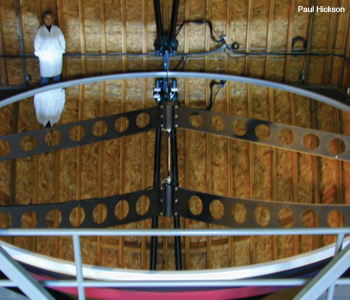Feature
The International Liquid Mirror Telescope
Early next year, the International Liquid Mirror Telescope—a collaboration between astronomical institutions in Belgium, Canada and India—will see first light. The instrument will provide substantial, in-depth sky coverage and make an unprecedented number of nightly observations.
 The Large Zenith Telescope uses a 6-m-diameter rotating container filled with a thin layer of liquid mercury. A layer of mercury oxide stops evaporation.
The Large Zenith Telescope uses a 6-m-diameter rotating container filled with a thin layer of liquid mercury. A layer of mercury oxide stops evaporation.
Scientists have known since Newton’s time that the surface of a spinning liquid takes the shape of a paraboloid. However, it wasn’t until two centuries ago that an astronomer—the Italian Ernesto Capocci—suggested using a rotating container filled with mercury as the primary mirror of an astronomical telescope. At that time, the concept was not taken seriously, primarily because a mercury mirror cannot be tilted to track moving objects.
…Log in or become a member to view the full text of this article.
This article may be available for purchase via the search at Optica Publishing Group.
Optica Members get the full text of Optics & Photonics News, plus a variety of other member benefits.
